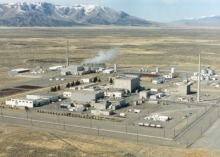Nations that export nuclear technology such as China and Russia are pouring a lot of resources into developing the "next" generation of commercial nuclear power reactors. This type of reactor is also knows as a Generation IV reactor (current power reactors are considered Generation III.) There are several different designed being pursued. These new reactors promise "significant advances in sustainability, safety and reliability, economics, physical protection and proliferation resistance." However, some of the new designs generate plutonium for future fuel and could be seen as a proliferation threat.
Thermal reactors utilize what are referred to as slow or "thermal" neutrons. A moderator slows neutrons to make capture by fuel more probable. The very high temperature reactor (VHTR) uses uranium fuel with helium or molten salt as a coolant. This reactor can produce one thousand degree heat for use in chemical processing. The Chinese began development of a new 200 megawatt VHTR design in 2012. A molten salt reactor contains molten salt as a coolant and may include the fuel as part of the molten salt. The neutrons in a molten salt reactor are technically faster than typical thermal neutrons. A supercritical water reactor (SCWR) uses steam under high pressure as the coolant and also utilizes neutrons that are faster than the usual thermal neutrons. This reactor is intended to produce cheap electricity using technology from Generation III reactors and supercritical fossil fuel power plants. The VVER-170/393 is a SCWR being developed by the Russians.
Fast reactors use the neutrons produced by fission events without any moderators slowing them down. Fast reactors can burn the spent fuel produced by Generation III reactors. They can also be designed to produce more fuel than they burn. Gas cooled fast reactors (GFR) make use of a gas to cool the reactor and drive a gas turbine for energy production. A European consortium is working on a 100 megawatt version of the GFR. Sodium cooled fast reactors (SFR) have sodium as a coolant and are often designed to passively stop the fission reactor if the reactor overheats. Special fuels and core designs are being developed to deal with the high temperatures in the reactor. The European consortium is working on a 600 megawatt SFR design. Russia has signed a contract to provide a BN-800 SFR reactor design to China. India is also working on an 800 megawatt SFR. Lead cooled fast reactors (LFR) are cooled by molten lead or an alloy of lead and bismuth. The European consortium is working on an 100 megawatt LFR. Russia is working on a couple of LFR designs.
The U.S. Department of Energy has been tasked with completing an operational prototype of a Generation IV reactor by 2021. Phase 2 would include developing a final design for a nuclear reactor prototype, applying for licenses to build and operate the reactor technology, building the prototype, and beginning operations by 2021.
In 2011, the DoE told Congress that it could not proceed with Phase 2 of the program to develop and construct a next generation reactor “until circumstances warranted a change in direction”. Some of the problems they had encountered included cost-share and site requirements which mandate that the new reactor prototype be built at the Idaho National Laboratory (INL). The new reactor is intended to produce heat that could be used for industrial process but locating it at the INL would mean that it would not be near an industrial area where the heat could be utilized. Therefore the possibility of private industry picking up some of the construction costs is remote.
The United States General Accounting Office recently issued a report that criticized the U.S. Department of Energy for falling behind in the race to develop a commercial Generation IV nuclear reactor. The GAO report says that the DoE must develop a strategy for proceeding with Phase 2 of the project to develop a next generation reactor that can be operational by 2021.
Idaho National Laboratory:
